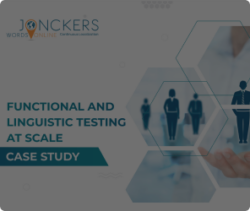Globalization has made launching software products and IT services faster, easier, and cheaper than ever. Today, businesses can leverage cloud technology to test and scale their ideas globally, instead of investing in infrastructure to do so locally. This dramatically reduces the cost and time to market, and frees up capital for research and development. In addition to virtual launches, businesses can partner with local vendors, hire local employees, and access physical resources at lower prices to further reduce expenses.
Yet despite the advantages, globalization increases the pressure to speed up development cycles, optimize costs, and automate processes—without sacrificing the user experience.
Linguistic and cultural differences add another layer of complexity when you launch in other markets. You need to localize software regularly in multiple languages, which is expensive and time-consuming—unless you have a scalable process in place.
Fortunately, AI-powered continuous localization enables you to quickly and accurately translate everything you need for a successful launch and ongoing releases.
To appreciate the benefits of continuous localization, you need a basic understanding of the software localization process. Simply put, it involves adapting software products to meet the linguistic, cultural, and other specific needs of a country or region—within the software design. This extends beyond text translation to adapt functionality, user interface, and design elements to ensure the product feels intuitive to local users.
Taking everything into account, software localization encompasses everything from initial development and launch to marketing, customer support, and ongoing updates.
Now that you know more about the software localization process, let’s look at five key business benefits it can provide.
Software localization enables you to reach a wider customer base and increase market penetration in the target locale. That’s because it takes into account the local language, culture, and user preferences. For example, let’s say you want to launch in Japan. You would not only need to translate content into Japanese, but also adapt the interface to meet the local preference for minimalist designs.
Furthermore, 65% of customers prefer to buy products with information in their own language. And 40% won’t buy in another language. By localizing your software, you’ll access a much larger portion of the local market. Even if your target customers typically speak English as a second language, you’ll gain a competitive advantage over products and services that are English-only.
By localizing software, you demonstrate your commitment to customer satisfaction and a global outlook. This can enhance your reputation, build customer trust, and create positive associations with the brand.
Adobe, for example, earned its position as a global leader in creative solutions by localizing software products, user interfaces, and documentation into multiple languages. Taking this approach made the company’s creative software more accessible and user-friendly for international customers.
Software localization enhances the user experience by adapting the product to the local market. It ensures users can navigate the interface, understand instructions, and interact more effectively.
For example, let’s say you want to localize software for the Indian market. You’ll need to develop an application that’s lightweight, fast-loading, and accommodates multiple languages. This will make it more user-friendly in the multilingual nation with low bandwidth environments.
When users can navigate your software intuitively, it reduces the need for customer support and training. As a result, you can allocate fewer resources to support the localized versions. For instance, if the user interface is clear and consistent, users may not need to contact customer support for help in navigating the software. This saves the company time and money.
Countries have different legal and regulatory requirements regarding language, content, data collection, and privacy. Software localization ensures compliance with these requirements, and allows you to operate in those markets without complications. In France, for example, software must include a French language version, and online services must include a French version of the data privacy policy.
Manually updating software and any accompanying materials is not only expensive and time-consuming. It can also make it difficult to ensure consistent quality across all languages and content due to the number of teams and departments involved. Fortunately, continuous localization automates the process and allows you to update software in multiple languages simultaneously for faster releases.
WordOnline is our proprietary continuous localization platform that manages translations for any type of content in any language in the cloud. It combines neural machine translation and translation memory technology with an AI-empowered translation community to deliver the highest-quality results. WordsOnline provides control, transparency, and scalability—no matter the size of your project.
To ensure quality, we have AI-powered verification throughout the platform, and all of our translators are trained, tested, and accredited. This guarantees that even the most complex technical and IT translations meet industry standards.
And our monthly subscription model enables you to manage your budget without having to approve every project. This reduces your translation costs and workload.
Yet you don’t need to take our word for it. Some of the biggest names in IT and software rely on WordsOnline. Here’s a look at 4 of our greatest success stories.
Microsoft Customer Experience & Success (CE&S), the division that provides global support for all Microsoft products, needed to localize its customer service-related content.
A hack or security threat can occur at any time. That’s why Microsoft CE&S needed a reliable translation partner to help them inform global customers of any patches or updates quickly and accurately in their own language.
We customized our workflow to be able to translate 1 million words per month and meet urgent deadlines—including overnight—in 47 languages.
We saved Microsoft over 50% in costs by combining neural machine translation with automated workflows and specialized post-editors.

In this case study, we’ll explore how Microsoft safeguards its reputation, how their corporate culture influences communications, and what types of content Microsoft CE & S regularly translate.
Adobe Experience League, the software’s e-learning hub, needed a partner to deliver a high volume of localized videos with subtitles, voiceover, and time-coded transcriptions.
The variety of topics and cross references to Adobe products, as well as the educational nature of the content, created an enormous linguistic challenge for the e-learning division.
By using offline tools like text-to-speech, we delivered localized subtitles and audio at a faster rate and reduced Adobe’s costs. In addition, we worked with Adobe’s linguists to ensure quality across all files and conducted quality checks for time coding and wording.
Adobe launched 8,000 fully localized videos within 8 months. The e-learning division enjoys a scalable localization experience that can expand for high volumes of content without compromising on quality standards.

We have the experience and expertise to ensure that Adobe’s video content is always accurate and up-to-date.
A multinational software development company that creates chatbots and digital assistants needed to record human-like voices in multiple languages.
Our client needed a partner who could translate content to train their digital assistants. And they needed to adapt the communications to reflect the distinct brand voice of each of their customers.
Our AI-powered translation platform connects the texts used to train these digital assistants with a network of professional translators. Then our trained linguists create multilingual answers that follow the brand’s guidelines based on the possible utterances and the autogenerated answers.
Our client became a market leader in virtual assistant development by offering more human-like virtual communications.

Digital Assistants Case Study Download your copy here! Introduction As artificial intelligence continues to advance, conversational AI has become an
Our clients are leading software and tech companies that have tight release schedules and regular updates. Each release needs quality assurance to protect the brands from costly bugs and performance issues that could damage their reputation.
With millions of users worldwide, our clients need to launch product updates on time, and with the highest level of quality. That means testers must scale their processes across multiple software products in order to provide reliable testing of new features.
Our client required us to hire and train 18 testers on one product within a week in order to ensure delivery from week one. We continued to scale at an unprecedented rate, and had 200+ testers within 9 weeks.
With our follow-the-sun methodology, the US development team was able to have the new coding checked through the night to deliver optimal efficiency and no downtime.

Testing Case Study Download your copy here! Introduction Are you looking for a reliable partner to help you with your
At Jonckers, we provide the customized solutions you need for a successful software release. We go beyond technical translations to provide continuous localization, functional testing, multilingual marketing, and more.
Ready to launch in a new market? Contact us today!
Upload your documents to WordsOnline and pay online for a fast, simple service. 10% discount on your first order
We will help you transition to the new world of continuous localization!

